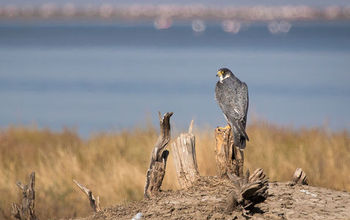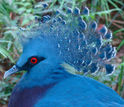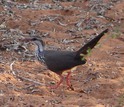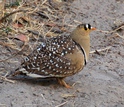Hola amigos : A VUELO DE UN QUINDE EL BLOG., hemos recibido la información de la Fundación Nacional de Ciencias de Los Estados Unidos; sobre la investigación de un equipo internacional sobre la evolución de las aves, que ellos denominan "The Big Bang" de las aves.
The National Science Foundation (NSF), nos dice "..........Los genomas de las aves modernas cuentan una historia: aladas gobernantes de hoy de los cielos surgieron y evolucionaron después de la extinción masiva que acabó con los dinosaurios y casi todo lo demás hace 66 millones años.......
Esa historia está saliendo a la luz, gracias a una colaboración internacional que ha estado en marcha desde hace cuatro años........
Los primeros resultados del Consorcio de la Phylogenomics aviar se están reportando casi simultáneamente en 23 documentos - ocho papeles en un número especial de esta semana de la Revista Ciencia, y 15 más en Genome Biology, GigaScience y otras revistas.......
Los resultados son financiados en parte por la National Science Foundation (NSF)......
Los científicos ya sabían que las aves que sobrevivieron a la extinción en masa experimentaron un rápido estallido de la evolución.
Pero el árbol genealógico de las aves modernas tenía a los biólogos confundidos durante siglos, y los detalles moleculares de cómo llegaron las aves en la espectacular biodiversidad de más de 10.000 especies fue apenas conocidos................
Pero el árbol genealógico de las aves modernas tenía a los biólogos confundidos durante siglos, y los detalles moleculares de cómo llegaron las aves en la espectacular biodiversidad de más de 10.000 especies fue apenas conocidos................
¿Cómo los pájaros vuelven tan diversos?
Para resolver estas cuestiones fundamentales, un consorcio liderado por Guojie Zhang del Banco Genético Nacional a BGI en China y la Universidad de Copenhague; neurocientífico Erich Jarvis, de la Universidad de Duke y del Instituto Médico Howard Hughes; y M. Thomas P. Gilbert del Museo de Historia Natural de Dinamarca ha secuenciado, montado y comparado los genomas completos de 48 especies de aves......
Los invito a leer con más detalles la versión en inglés abajo......
Genes reveal histories of bird origins, feathers, flight and song
 Credit and Larger Version |
December 11, 2014
The genomes of modern birds tell a story: Today's winged rulers of the skies emerged and evolved after the mass extinction that wiped out dinosaurs and almost everything else 66 million years ago.
That story is now coming to light, thanks to an international collaboration that has been underway for four years.
The first findings of the Avian Phylogenomics Consortium are being reported nearly simultaneously in 23 papers--eight papers in a special issue this week of Science, and 15 more in Genome Biology, GigaScience and other journals.
The results are funded in part by the National Science Foundation (NSF).
Scientists already knew that the birds that survived the mass extinction experienced a rapid burst of evolution.
But the family tree of modern birds has confused biologists for centuries, and the molecular details of how birds arrived at the spectacular biodiversity of more than 10,000 species was barely known.
How did birds become so diverse?
To resolve these fundamental questions, a consortium led by Guojie Zhang of the National Genebank at BGI in China and the University of Copenhagen; neuroscientist Erich Jarvis of Duke University and the Howard Hughes Medical Institute; and M. Thomas P. Gilbert of the Natural History Museum of Denmark has sequenced, assembled and compared the full genomes of 48 bird species.
The species include the crow, duck, falcon, parakeet, crane, ibis, woodpecker, eagle and others, representing all major branches of modern birds.
"BGI's strong support and four years of hard work by the entire community have enabled us to answer numerous fundamental questions on an unprecedented scale," said Zhang.
"This is the largest whole genomic study across a single vertebrate class to date. The success of this project can only be achieved with the excellent collaboration of all the consortium members."
Added Gilbert, "Although an increasing number of vertebrate genomes are being released, to date no single study has deliberately targeted the full diversity of any major vertebrate group.
"This is what our consortium set out to do. Only with this scale of sampling can scientists truly begin to fully explore the genomic diversity within a full vertebrate class."
"This is an exciting moment," said Jarvis. "Lots of fundamental questions now can be resolved with more genomic data from a broader sampling. I got into this project because of my interest in birds as a model for vocal learning and speech production in humans, and it has opened up some amazing new vistas on brain evolution."
This first round of analyses suggests some remarkable new ideas about bird evolution.
The first flagship paper published in Science presents a well-resolved new family tree for birds, based on whole-genome data.
The second flagship paper describes the big picture of genome evolution in birds.
Six other papers in the special issue of Science report how vocal learning may have independently evolved in a few bird groups and in the human brain's speech regions; how the sex chromosomes of birds came to be; how birds lost their teeth; how crocodile genomes evolved; and ways in which singing behavior regulates genes in the brain.
New ideas on bird evolution
"This project represents the biggest step forward yet in our understanding of how bird diversity is organized and in time and space," said paper co-author Scott Edwards, on leave from Harvard University and currently Director of NSF's Division of Biological Infrastructure.
"Because this information is so fundamental to our understanding of biodiversity, it will help everyone--from birdwatchers to artists to museum curators--better organize knowledge of bird diversity."
The new bird tree will change the way we think about bird diversity, said Edwards. "The fact that many birds associated with water--loons, herons, penguins, petrels and pelicans--are closely related suggests that adaptations to lakes or seas arose less frequently than we thought."
Added paper co-author David Mindell, an evolutionary biologist and program director in NSF's Division of Environmental Biology, "We found strong support for close relationships that might be surprising to many observers.
"Grebes are closely related to flamingos, but not closely related to ducks; falcons are closely related to songbirds and parrots but not closely related to hawks; and swifts are closely related to hummingbirds and not closely related to swallows."
Genome-scale datasets allowed scientists to "track the sequence of divergence events and their timing with greater precision than previously possible," said Mindell.
"Most major types of extant birds arose during a 5-10 million year interval at the end of the Cretaceous period and the extinction of non-avian dinosaurs about 66 million years ago."
It takes a consortium...of 200 scientists, 80 institutions, 20 countries
The Avian Phylogenomics Consortium has so far involved more than 200 scientists from 80 institutions in 20 countries, including the BGI in China, the University of Copenhagen, Duke University, the University of Texas at Austin, the Smithsonian Institution, the Chinese Academy of Sciences, Louisiana State University and others.
Previous attempts to reconstruct the avian family tree using partial DNA sequencing or anatomical and behavioral traits have met with contradiction and confusion.
Because modern birds split into species early and in such quick succession, they did not evolve enough distinct genetic differences at the genomic level to clearly determine their early branching order, the researchers said.
To resolve the timing and relationships of modern birds, consortium scientists used whole-genome DNA sequences to infer the bird species tree.
"In the past, people have been using 10 to 20 genes to try to infer the species relationships," Jarvis said.
"What we've learned from doing this whole-genome approach is that we can infer a somewhat different phylogeny [family tree] than what has been proposed in the past.
"We've figured out that protein-coding genes tell the wrong story for inferring the species tree. You need non-coding sequences, including the intergenic regions. The protein-coding sequences, however, tell an interesting story of proteome-wide convergence among species with similar life histories."
Where did all the birds come from?
This new tree resolves the early branches of Neoaves (new birds) and supports conclusions about relationships that have been long-debated.
For example, the findings support three independent origins of waterbirds.
They also indicate that the common ancestor of core landbirds, which include songbirds, parrots, woodpeckers, owls, eagles and falcons, was an apex predator, which also gave rise to the giant terror birds that once roamed the Americas.
The whole-genome analysis dates the evolutionary expansion of Neoaves to the time of the mass extinction event 66 million years ago.
This contradicts the idea that Neoaves blossomed 10 to 80 million years earlier, as some recent studies have suggested.
Based on this new genomic data, only a few bird lineages survived the mass extinction.
They gave rise to the more than 10,000 Neoaves species that comprise 95 percent of all bird species living with us today.
The freed-up ecological niches caused by the extinction event likely allowed rapid species radiation of birds in less than 15 million years, which explains much of modern bird biodiversity.
For answers, new computational tools needed
Increasingly sophisticated and more affordable genomic sequencing technologies, and the advent of computational tools for reconstructing and comparing whole genomes, have allowed the consortium to resolve these controversies with better clarity than ever before, the researchers said.
With about 14,000 genes per species, the size of the datasets and the complexity of analyzing them required new approaches to computing evolutionary family trees.
These were developed by computer scientists Tandy Warnow at the University of Illinois at Urbana-Champaign, funded by NSF, Siavash Mirarab of the University of Texas at Austin, and Alexis Stamatakis at the Heidelburg Institute for Theoretical Studies.
Their algorithms required the use of parallel processing supercomputers at the Munich Supercomputing Center, the Texas Advanced Computing Center, and the San Diego Supercomputing Center.
"The computational challenges in estimating the avian species tree used around 300 years of CPU time, and some analyses required supercomputers with a terabyte of memory," Warnow said.
The bird project also had support from the Genome 10K Consortium of Scientists (G10K), an international science community working toward rapidly assessing genome sequences for 10,000 vertebrate species.
"The Avian Genomics Consortium has accomplished the most ambitious and successful project that the G10K Project has joined or endorsed," said G10K co-leader Stephen O'Brien, who co-authored a commentary on the bird sequencing project in GigaScience.
-NSF-
Media Contacts Cheryl Dybas, NSF, (703) 292-7734,
cdybas@nsf.gov
Karl Bates, Duke University, (919) 681-8054,
Karl Bates, Duke University, (919) 681-8054,
The National Science Foundation (NSF) is an independent federal agency that supports fundamental research and education across all fields of science and engineering. In fiscal year (FY) 2014, its budget is $7.2 billion. NSF funds reach all 50 states through grants to nearly 2,000 colleges, universities and other institutions. Each year, NSF receives about 50,000 competitive requests for funding, and makes about 11,500 new funding awards. NSF also awards about $593 million in professional and service contracts yearly.
Useful NSF Web Sites:
NSF Home Page: http://www.nsf.gov
NSF News: http://www.nsf.gov/news/
For the News Media: http://www.nsf.gov/news/newsroom.jsp
Science and Engineering Statistics: http://www.nsf.gov/statistics/

Learn more about relationships among birds.
Credit and Larger Version

These rainbow lorikeets are representative of parrots.
Credit and Larger Version

About 70 million years ago, Columbea, which includes the crowned pigeon, diverged from Passerea.
Credit and Larger Version

The group Columbea includes the subdesert mesite.
Credit and Larger Version

Double-banded sandgrouse are also members of Columbea.
Credit and Larger Version

The researchers' work is described in the Dec. 12, 2014, issue of Science.
Credit and Larger Versión
The National Science Foundation (NSF)
Guillermo Gonzalo Sánchez Achutegui
ayabaca@gmail.com
ayabaca@yahoo.com
ayabaca@hotmail.com
Inscríbete en el Foro del blog y participa : A Vuelo De Un Quinde - El Foro!

No hay comentarios:
Publicar un comentario